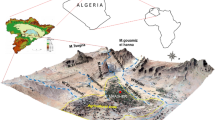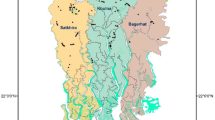Abstract
The Senegal North littoral aquifer bears considerable groundwater resources that face both natural and anthropogenic constraints due to proximity of the ocean and numerous socio-economic activities in this semi-arid region. The present study aims to understand spatial and seasonal hydrochemistry variability of this groundwater. Chemical data were analyzed with statistics methods such as Principal Component Analysis and Hierarchical Classification Analysis to classify water types and to decipher geochemical processes. A set of 32 wells was repeatedly sampled in four campaigns between 2010 and 2012 and chemically analyzed in addition to rainwater samples. Results exhibited five water types viz Ca–SO4, Na–Cl/SO4, mixed-Cl/SO4, mixed-HCO3/Cl and Ca–HCO3 geographically discriminated in the study region. The last two water types dominate; they occur mostly in the central and eastern part of the aquifer. Whereas the first two highly mineralized classes occur in the narrow coastal strip zone. Natural processes such as dissolution of evaporite minerals (gypsum, halite), carbonate minerals (calcite, dolomite), exchange reaction in addition to anthropogenic sulphate (from mining industry) and nitrate (from agriculture) inputs are the likely dominant processes that control the water chemistry. Chemical changes proceed according to seasonal variability as infiltrating waters reach the water table. The mean global mineralization which is higher in October in post-rainy season (818 µs/cm) and lower in February in the mid of dry season (640 µs/cm) suggests dilution process through delayed recharge. The environmental isotope (δ18O, δ2H, 3H) measurements further revealed that groundwater in the system is relatively well-mixed as shown by the measured range of values. However, deviation from the rainwater signature indicates combined effect of evaporation processes which may occur at the top surface and in the unsaturated zone during infiltration and also mixing with anthropogenic contribution to the aquifer. Tritium contents in the system compared to those of rainwater confirm differences in infiltration rates where the northern central zone with low 3H contents suggests water prior to thermonuclear bumb test era between 1952 and 1953.










Similar content being viewed by others
References
Adams S, Titus R, Pietersen K, Tredoux G, Harris C (2001) Hydrochemical characteristics of aquifers near Sutherland in the western Karoo South Africa. Hydrol J 241(1–2):91–103
Alberto WD, Del Pilar DM, Valeria AM, Fabiana PS, Cecilia HA, De los Angles BM (2001) Pattern recognition techniques for evaluation of spatial and temporal variations in water quality, a case study: Suquia river basin (Cordoba–Argentina). Water Resour 35:2881–2894
Alther GA (1979) A simplified statistical sequence applied to routine water quality analysis: a case history. Ground Water 17:556–561
Ashley RP, Lloyd JW (1978) An example of the use of factor analysis and cluster analysis in groundwater chemistry interpretation. J Hydrol 39(3–4):335–364
Birke M, Rauch U (1993) Environmental aspects of the regional geochemical survey in the southern part of east Germany. J Geochem Explor 49(1–2):35–61
Brown CE (1998) Applied multivariate statistics in geohydrology and related sciences. Springer, Berlin, p 248
Chkir N, Trabelsi R, Bahir M, Hadj Ammar F, Zouari K, Chamchati H, Monteiro JP (2008) Vulnérabilité des ressources en eaux des aquifères côtiers en zones semi-arides—Etude comparative entre les bassins d’Essaouira (Maroc) et de la Jeffara (Tunisie). Comun Geol 95:107–121
Cissé I, Fall ST, Badiane M, Diop Y, Diouf A (2006) Horticulture et usage des pesticides dans la zone des Niayes, ISRA/LNERV, EISMV, LACT/Faculté de Médecine Pharmacie/UCAD, document de travail Ecocité 8 p 14
GKW Consult (2009) Projet Eau à Long Terme–Etudes Hydrogéologiques Complémentaires. Rapport Final Dakar et Littoral Nord p 58 ( + Annexes)
Coplen TB (1988) Normalization of oxygen and hydrogen isotope data. Chem Geol Isot Geosci Sect 72:293–297
Craig H (1961) Isotope variations in meteoric water. Science 133:1702–1703
Demlie M, Wohnlich S, Gizaw B, Stichler W (2007) Groundwater recharge in the Akaki catchment, central Ethiopia: evidence from environmental isotopes (δ18O, δ2H and 3H) and chloride mass balance. Hydrol Process 21:807–818
Diedhiou M (2011) Approche multitraceur géochimique et isotopique à l’identification des sources de la pollution nitratée et des processus de nitrification et dénitrification dans la nappe de Thiaroye. Thèse de doctorat unique, Univ, Cheikh Anta Diop de Dakar, Dakar 210
Dragon K, Gorski J (2015) Identification of groundwater chemistry origins in a regional aquifer system (Wielkopolska region, Poland) Environ. Earth Sci 73:2153–2167
Edmunds WM, Gaye CB (1994) Estimating the spatial variability of the groundwater recharge in the Sahel using chloride. J Hydrol 156:47–59
Faye S (1995) Modélisation hydrodynamique de la nappe du Littoral Nord entre Cayar et Saint louis, Impact des futurs prélèvements sur l’approvisionnement de Dakar et ses envions Louis PH D, Département Géologie, Univ. C. A. Diop, p 101 ( + annexes)
Faye S, Gaye CB, Faye A, Malou R (1992) Solute profile in unsaturated Quaternary sands from Senegal: environmental information and water-rock interaction. Water–Rock Interaction, Kharaka & Maest. 1–5
Faye S, Gaye CB, Faye A, Malou R (1997) Impact of additional exploitation on the Littoral aquifers in the North of Senegal. XXVII IAH Congress, Nottingham. Groundwater in the Urban Environment Problems, Processes and Management, Balkema-Rotterdam 1–5
Gaye CB (1990) Etude isotopique et géochimique du mode de recharge par les pluies et de décharge évaporatoire des aquifères libres sous climat semi-aride au nord du Sénégal. PH D, Département Géologie, Univ. C. A. Diop, p 280 ( + annexes)
Gaye CB, Edmunds WM (1996) Groundwater recharge estimation using chloride, stable isotopes and tritium profiles in the sands of northwestern Senegal. Environ. Geology 27:246–251
Giambastiani BMS, Colombani N, Mastrocicco M, Fidelibus MD (2013) Characterization of the lowland coastal aquifer of Comacchio (Ferrara, Italy): hydrology, hydrochemistry and evolution of the system. J Hydrol 501:35–44
Güler C, Thyne GD, McCray JE, Turner AK (2002) Evaluation of graphical and multivariate statistical methods for classification of water chemistry data. Hydrogeol J 10:455–474
Güler C, Kurt MA, Alpaslan M, Akbulut C (2012) Assessment of the impact of anthropogenic activities on the groundwater hydrology and chemistry in Tarsus coastal plain (Mersin, SE Turkey) using fuzzy clustering, multivariate statistics and GIS techniques. J Hydrol 414–415:435–451
Hadas A, Sagiv B, Haruvy N (1999) Agricultural practices, soil fertility management modes and resultant nitrogen leaching rates under semi-arid conditions. Agric Water Manag 42:81–95
Helena B, Pardo R, Vega M, Barrado E, Fernandez JM, Fernandez L (2000) Temporal evolution of ground water composition in an alluvial aquifer (Pisuerga River, Spain) by principal component analysis. Water Resour 34:807–816
IDEV-ic ex SENEGROSOL/COWI (2011) Etude du projet de mise en œuvre du plan d’Action de Gestion Intégrée des Ressources en eau (2ème Partie) Bilan diagnostic des Ressources en eau. Rapport Technique p 21
Kane CH (1995) Contribution à l’étude hydrochimique de la nappe des sables quaternaires du Littoral Nord au Sénégal entre Kayar et Saint Louis Thèse de doctorat 3ème cycle, Département de Géologie, Université C. A. Diop, p 162 ( + annexes)
Laaksoharjua M, SkaÊrmana C, SkaÊrmanb E (1999) Multivariate mixing and mass balance (M3) calculations, a new tool for decoding hydrogeochemical information. Appl Geochem 14:861–871
Leduc C, Tgupin J, Le Gal La Salle C. (1996) Estimation de la recharge de la nappe phréatique du Continental Terminal (Niamey, Niger) à partir des teneurs en tritium. Géosciences de surface/(Hydrogéologie–Hydrogéologie) C.R. Acad. Sci. Paris, 323, série II a, p 599 à 605
Madioune DH, Faye S, Orban P, Brouyère S, Dassargues A, Mudry J, Stumpp C, Maloszewski P (2014) Application of isotopic tracers as a tool for understanding hydrodynamic behavior of the highly exploited Diass aquifer system (Senegal). J Hydrol 511:443–459
Noel Y (1978) Etude hydrogéologique des calcaires lutétiens entre Bambey et Louga (2ème phase) Rapport BRGM 78 Dak 02, p 82
Reeve AS, Siegel DI, Glaser PH (1996) Geochemical controls on peatland pore water from the Hudson bay lowland: a multivariate statistical approach. Hydrol J 181(1–4):285–304
Singh B, Singh Y, Sekhon GS (1995) Fertilizer-N use efficiency and nitrate pollution of groundwater in develo** countries. J Contam Hydrol 20:167–184
Swanson SK, Bahr JM, Schwar MT, Potter KW (2001) Two-way cluster analysis of geochemical data to constrain spring source waters. Chem Geol 179:73–91
Thatcher L, Janzer VJ, Edwards RW (1977) Methods for determination of radioactive substances in water and fluvial sediments. In: Techniques of Water Resources Investigations of the US Geological Survey. US Government Printing Office, Washington, DC Books 5 pp 79–81 (Chapter A5)
Travi Y, Gac JY, Fontes JC, Fritz B (1987) Reconnaissance chimique et isotopique des eaux de pluie au Sénégal. Géodynamique 2:43–53
Zghibi A, Tarhouni J, Zouhri L (2013) Assessment of seawater intrusion and nitrate contamination on the groundwater quality in the Korba coastal plain of Cap-Bon (North–east of Tunisia). J Afr Earth Sci 87:1–12
Acknowledgments
The authors thank the High Education Ministry of Senegal and French Cooperation for funding this research. They also thank UMR 6143 M2C laboratory of Rouen University, Department of Geology of Cheikh Anta Diop University in Dakar.
Author information
Authors and Affiliations
Corresponding author
Rights and permissions
About this article
Cite this article
Kaba, M., Mesnage, V., Laignel, B. et al. Spatial and seasonal variability of groundwater hydrochemistry in the Senegal North Littoral aquifer using multivariate approach. Environ Earth Sci 75, 724 (2016). https://doi.org/10.1007/s12665-016-5520-x
Received:
Accepted:
Published:
DOI: https://doi.org/10.1007/s12665-016-5520-x




